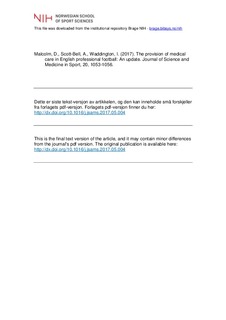The provision of medical care in English professional football: An update
Journal article, Peer reviewed
Accepted version
Permanent lenke
http://hdl.handle.net/11250/2597047Utgivelsesdato
2017Metadata
Vis full innførselSamlinger
- Artikler / Articles [2119]
- Publikasjoner fra Cristin [1107]
Originalversjon
Journal of Science and Medicine in Sport. 2017, 20, 1053-1056. 10.1016/j.jsams.2017.05.004Sammendrag
Objectives: To compare the current methods of appointment, qualifications and occupational experience of club doctors and physiotherapists in English professional football with (i) those outlined in a study published in 1999, and (ii) Football Association (FA) medical regulations. Design: Qualitative. Methods: Postal questionnaire survey of (head) doctors and physiotherapists at each of the clubs in the English Premiership, Championship and Football Leagues 1 and 2. Response rates of 35.8% and 45.6% respectively were obtained. Results: The majority of football club doctors are GPs who have sports medicine qualifications and relevant occupational experience. Time commitments vary from full time to a few hours per week. Most are appointed through personal contacts rather than job advertisements and/or interview. Almost all football clubs have a chartered physiotherapist, many of whom have a postgraduate qualification. They work full time and long hours. Most are appointed through personal contacts rather than job advertisements. They are frequently interviewed but not always by someone qualified to judge their professional expertise. Conclusions: Football club medical provision has become more extensive and increasingly professional over the last 10–20 years, with better qualified, more career-oriented and more formally contracted staff. It is likely that clinical autonomy has subsequently increased. However recruitment procedures still need to be improved, especially in relation to advertising vacancies, interviewing candidates, and including medical personnel on interview panels. In two aspects clubs appear not to be compliant with current FA medical regulations.
Beskrivelse
I Brage finner du siste tekst-versjon av artikkelen, og den kan inneholde ubetydelige forskjeller fra forlagets pdf-versjon. Forlagets pdf-versjon finner du på sciencedirect.com / In Brage you'll find the final text version of the article, and it may contain insignificant differences from the journal's pdf version. The definitive version is available at sciencedirect.com
